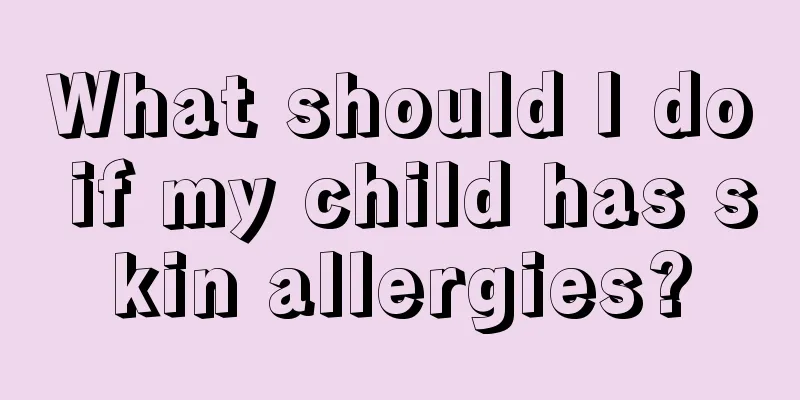What to do if children have phlegm in their lungs

|
Children are affected by the environment and are likely to have phlegm that they cannot cough out. Over time, they are prone to pneumonia. If they have a fever at this time, it is caused by a lung infection. It is best to take your child to the hospital for a check-up and receive treatment according to the doctor's advice. In addition to taking medication, parents should also take more careful care of their children in terms of life and diet. Treatment can be assisted by massage, drinking plenty of water, and eating foods that help clear phlegm. What to do if children have phlegm in their lungs 1. Air pollution caused by dry cold, no snow and heavy fog seriously irritates children's respiratory tract. At Beijing Children's Hospital, after the winter begins, the hospital needs to receive more than 5,000 children every day, of which 60% to 70% suffer from upper respiratory tract infections. Symptoms include cough, runny nose, and nasal congestion. Some children have phlegm in their lungs, but they cannot cough it out by themselves. The phlegm accumulates in the lungs and becomes thick. Over time, the texture of the lungs will thicken, causing lower respiratory tract infections, usually bronchitis, and in severe cases it will turn into pneumonia. 2. At this time, the viral infection merges into a bacterial infection, and the child's symptoms are fever and increased white blood cell count. If your child's cough persists for a week and medication is ineffective, you need to go to the hospital for an X-ray examination. But don't take your child to the hospital frequently. The doctor said that the most taboo thing when a child is sick is to take him to the hospital every day, as that will lead to cross infection. 3. Parents must insist on giving their children medication as directed by the doctor, because it takes some time for each medicine to take effect. But anxious parents always hope that the medicine will cure the disease immediately. If they give their children one medicine and see if it doesn’t work, they will quickly switch to another one. The doctor said that this method of frequent dressing changes is not advisable. Precautions for children with phlegm in their lungs 1. After the massage, give your baby plenty of warm water or lightly salted water. If you insist on massaging your baby twice a day and combining it with diet therapy, your baby's illness will heal quickly. 2. Children with phlegm in their lungs should also avoid certain foods. It would be more appropriate to eat more steamed or boiled foods. In terms of food variety, you can consider increasing the intake of vegetables and fruits appropriately. You can eat pears appropriately to nourish the lungs, moisten the intestines, promote bowel movements, and prevent coughs. 3. Some babies are too young to cough up phlegm, so parents can turn the baby over or pat his back appropriately to promote blood circulation in the baby's lungs. In addition, this practice helps loosen the phlegm in the trachea and facilitates coughing it out. Nursing care for children with pneumonia (1) Environment: The indoor temperature for newborns should be between 20℃ and 24℃, the relative humidity should be maintained at 60%, and the indoor air should be ventilated, but convection should be avoided to prevent cold. (2) Body position: Pay attention to changing body position frequently, lie on your side with your head elevated, and keep the airway open to facilitate the discharge of secretions. (3) Feeding: The child should be provided with adequate calories, nutrition and water. If the condition is critical, breastfeeding and medication should be suspended to avoid vomiting and suffocation. If cyanosis appears around the child's mouth and nose or choking occurs during feeding, feeding should be stopped immediately and the child should be given oxygen. After the condition stabilizes, breastfeeding should also be in small amounts and multiple times. (4) Oxygen inhalation: If the child has shortness of breath or cyanosis around the lips, oxygen should be given immediately. For those who are restless or have excessive nasal secretions, oxygen can be given using the funnel method, with a dosage of 1 to 2 L per minute. When in use, the edge of the funnel should be about 1 cm away from the mouth and nose. If it is too far, oxygen will be wasted and the effect will be poor. If it is too close, gas exchange will be affected and breathing difficulties will be aggravated. After the child is calm, the nasal cannula method can be used instead, and oxygen should be inhaled intermittently. (5) Suctioning: In pneumonia, respiratory secretions increase, but newborns have low reflexes and cannot cough up sputum, so suctioning is necessary to keep the respiratory tract open and prevent suffocation. When suctioning sputum, use mouth-to-mouth or a large syringe connected to a catheter to suction sputum. The suction action should be gentle to avoid excessive stimulation. (6) Body temperature: The body temperature of newborns with pneumonia is usually normal. If the body temperature is high, physical cooling can be used. Generally, antipyretic drugs are not needed to prevent collapse caused by excessive sweating. (7) During infusion: 4 to 6 drops per minute is appropriate to avoid aggravating the condition by causing pulmonary edema or heart failure due to too fast a rate. (8) Poor reaction ability of newborns: Pneumonia often has no respiratory symptoms at the beginning, so the heart rate and breathing should be closely monitored. If there is foaming at the mouth, pale face, purple lips, and refusal to feed, it means that the condition is serious and active rescue and treatment are required. |
<<: How many heart beats per minute for a primary school student
>>: What causes painful urination in young children?
Recommend
What should children pay attention to after tooth extraction?
Tooth extraction is a common method of treating d...
Reasons why children have difficulty breathing while sleeping
At home, it is inevitable that some of our parent...
Reasons for a one and a half month old baby to spit up milk
It is very difficult to take care of babies when ...
How to remove moles on children's faces
Adults pay great attention to their appearance. O...
The dangers of early development in girls
Parents would like to see their children's bo...
What to do if your three-year-old baby has yellow teeth
Everyone wants to have white teeth. But many time...
What to do if your baby always gets better from a cold
Children can be said to be the treasure of a fami...
What causes white spots on children's teeth?
Some parents find a phenomenon when taking care o...
At what age is it better for children to sleep alone?
Children are very cute and like to sleep next to ...
Is it necessary to get the hand, foot and mouth vaccine?
Hand, foot and mouth disease is a common disease ...
Children's toenails are concave
Each of us is a different individual, and everyon...
What to do if your three-month-old baby is zinc deficient
A three-month-old baby is still very small. This ...
Can fetal lung cystadenoma be misdiagnosed?
Fetal lung cystic tumors have a huge impact on pa...
What are the reasons for the baby's big belly
In real life, we see that the belly of a newborn ...
How to treat ulcers at the corners of the mouth in children
Every winter to early spring, many children suffe...









